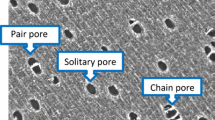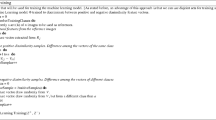Abstract
The recognition of forest species is a very challenging task that generally requires well-trained human specialists. However, few reach good accuracy in classification due to the time taken for their training; then they are not enough to meet the industry demands. Computer vision systems are a very interesting alternative for this case. The construction of a reliable classification system is not a trivial task, though. In the case of forest species, one must deal with the great intra-class variability and also the lack of a public available database for training and testing the classifiers. To cope with such a variability, in this work, we propose a two-level divide-and-conquer classification strategy where the image is first divided into several sub-images which are classified independently. In the lower level, all the decisions of the different classifiers, trained with different features, are combined through a fusion rule to generate a decision for the sub-image. The higher-level fusion combines all these partial decisions for the sub-images to produce a final decision. Besides the classification system we also extended our previous database, which now is composed of 41 species of Brazilian flora. It is available upon request for research purposes. A series of experiments show that the proposed strategy achieves compelling results. Compared to the best single classifier, which is a SVM trained with a texture-based feature set, the divide-and-conquer strategy improves the recognition rate in about 9 percentage points, while the mean improvement observed with SVMs trained on different descriptors was about 19 percentage points. The best recognition rate achieved in this work was 97.77 %.











Similar content being viewed by others
References
Thomas, L., Milli, L.: A robust gm-estimator for the automated detection of external defects on barked hardwood logs and stems. IEEE Trans Sig Proc 55, 3568–3576 (2007)
Huber, H.A.: A computerized economic comparison of a conventional furniture rough mill with a new system of processing. For Prod J 21(2), 34–39 (1971)
Buechler DN, Misra DK (2001) Subsurface detection of small voids in low-loss solids. In: First ISA/IEEE conference sensor for industry, pp 281–284
Cavalin PR, Oliveira LS, Koerich A, Britto AS (2006) Wood defect detection using grayscale images and an optimized feature set. In: 32nd Annual conference of the IEEE industrial electronics society, Paris, France, pp 3408–3412
Vidal, J.C., Mucientes, M., Bugarin, A., Lama, M.: Machine scheduling in custom furniture industry through neuro-evolutionary hybridization. Appl Soft Comput 11, 1600–1613 (2011)
Puiri, V., Scotti, F.: Design of an automatic wood types classification system by using fluorescence spectra. IEEE Trans Syst Man Cybern Part C 40(3), 358–366 (2010)
Paula PL, Oliveira LS, Britto AS, Sabourin R (2010) Forest species recognition using color-based features. Int Conf Pattern Recognit, pp 4178–4181
Tsuchikawa, S., Hirashima, Y., Sasaki, Y., Ando, K.: Near-infrared spectroscopic study of the physical and mechanical properties of wood with meso- and micro-scale anatomical observation. Appl Spectrosc 59(1), 86–93 (2005)
Nuopponen, M.H., Birch, G.M., Sykes, R.J., Lee, S.J., Stewart, D.J.: Estimation of wood density and chemical composition by means of diffuse reflectance mid-infrared Fourier transform (drift-mir) spectroscopy. Agric Food Chem 54, 34–40 (2006)
Orton, C.R., Parkinson, D.Y., Evans, P.D.: Fourier transform infrared studies of heterogeneity, photodegradation, and lignin/hemicellulose ratios within hardwoods and softwoods. Appl Spectrosc 583, 1265–1271 (2004)
Lavine, B.K., Davidson, C.E., Moores, A.J., Griffiths, P.R.: Raman spectroscopy and genetic algorithms for the classification of wood types. Appl Spectrosc 55, 960–966 (2001)
Martins, J., Oliveira, L.S., Nisgoski, S., Sabourin, R.: A database for automatic classification of forest species. Mach Vis Appl 24(3), 567–578 (2013)
Zavaschi, T., Oliveira, L.S., Souza Jr, A.B., Koerich, A.: Fusion of feature sets and classifiers for facial expression recognition. Expert Syst Appl 40(2), 646–655 (2013)
Cavalin PR, Oliveira LS, Koerich A, Britto AS (2012) Combining textural descriptors for forest species recognition. In: 32nd Annual conference of the IEEE industrial electronics society, Montreal, Canada
Tou JY, Lau PY, Proceedings of Y. H. Tay (2007) Computer vision-based wood recognition system. In: International workshop on advanced image technology
Tou JY, Tay YH, Lau PY (2008) One-dimensional grey-level co-occurrence matrices for texture classification. In: International symposium on information technology (ITSim 2008), pp 1–6
Tou, J.Y., Tay, Y.H., Lau, P.Y.: A comparative study for texture classification techniques on wood species recognition problem. Int Conf Nat Comput 5, 8–12 (2009)
Khalid M, Lee ELY, Yusof R, Nadaraj M (2008) Design of an intelligent wood species recognition system. IJSSST 9(3)
Nasirzadeh M, Khazael AA, Khalid MB (2010) Woods recognition system based on local binary pattern. In: Second international conference on computational intelligence, communication systems and networks, pp 308–313
Kittler, J., Hatef, M., Duin, R.P.W., Matas, J.: On combining classifiers. IEEE Trans Pattern Anal Mach Intell 20, 226–239 (1998)
Kuncheva L (2004) Combining pattern classifiers. In: Methods and Algorithms, Wiley, New York
Saso, D., Zenko, B.: Is combining classifiers with stacking better than selecting the best one? Mach Learn 54(3), 255–273 (2004)
Dong Y-S, Han K-S (2005) Boosting SVM classifiers by ensemble. In: Special interest tracks and posters of the 14th International Conference on World Wide Web. ACM, p 1073
Rokach, L.: Ensemble-based classifiers. Artif Intell 33(1–2), 1–39 (2010)
Zhu J, Steven CH, Michael R, Shuicheng Y (2008) Near duplicate keyframe retrieval by nonrigid image matching. ACM Multimedia, pp 41–50
Haralick RM (1979) Statistical and structural approaches to texture. Proc IEEE, 67(5)
Franco, A., Nanni, L.: Fusion of classifiers for illumination robust face recognition. Expert Syst Appl 36, 8946–8954 (2009)
Ojala, T., Pietikainen, M., Harwood, D.: A comparative study of texture measures with classification based on featured distribution. Pattern Recognit 29(1), 51–59 (1996)
Ojala, T., Pietikainen, M., Mäenpää, T.: Multiresolution gray-scale and rotation invariant texture classification with local binary patterns. IEEE Trans Pattern Anal Mach Intell 24(7), 971–987 (2002)
Zhao, G., Ahonen, T., Matas, J., Pietikainen, M.: Rotation-invariant image and video description with local binary pattern features. IEEE Trans Image Process 21, 1465–1477 (2012)
Mandelbrot, B.B.: The fractal geometry of nature. W. H. Freeman and Co, New York (1982)
Chen WS, Yuan SY, Hsiao H, Hsieh CM (2001) Algorithms to estimating fractal dimension of textured images. In: IEEE international conferences on acoustics, speech and signal processing, pp 1541–1544
Voss, R.F.: Characterization and measurement of random fractals. Phisica Scripta 27(13), 27–32 (1986)
Melo RHC, Conci A (2008) Succolarity: defining a method to calculate this fractal measure. In: 15th International conference on systems, signals and image processing, pp 291–294
Levi K, Weiss Y (2004) Learning object detection from a small number of examples. the importance of good features. In: Proceedings of the 2004 IEEE Computer Society Conference on Computer Vision and Pattern Recognition, 2004. CVPR 2004, june. 2 July 2004, vol 2, pp II-53–II-60
Ojansivu V, Heikkila J (2008) Blur insensitive texture classification using local phase quantization. In: Proc. of the image and signal processing (ICISP 2008), pp 236–243
Ojansivu V, Rahtu E, Heikkila J (2008) Rotation invariant local phase quantization for blur insensitive texture analysis. In: International conference on pattern recognition, pp 1–4
Huang X, Li SZ, Wang Y (2004) Shape localization based on statistical method using extended local binary pattern. In: Proc. of the international conference on image and graphics, pp 184–187
Liao, S., Law, M.W.K., Chung, A.C.S.: Dominant local binary patterns for texture classification. IEEE Trans Image Process 18(5), 1107–1118 (2009)
Heikkilä, M., Pietikäinen, M., Schmid, C.: Description of interest regions with local binary patterns. Pattern Recognit 42(3), 425–436 (2009)
Guo, Z., Zhang, L., Zhang, D.: A completed modeling of local binary pattern operator for texture classification. IEEE Trans Image Process 19(6), 1657–1663 (2010)
Platt, J.: Probabilistic outputs for support vector machines and comparisons to regularized likelihood methods. In: Smola, A. (ed.) Advances in Large Margin Classifiers, pp. 61–74. MIT Press, Cambridge (1999)
Yusof R, Rosli NR, Khalid M (2010) Using gabor filters as image multiplier for tropical wood species recognition system. In: 12th International conference on computer modelling and simulation, pp 284–289
Acknowledgments
This research has been supported by The National Council for Scientific and Technological Development (CNPq) grant 301653/2011-9.
Author information
Authors and Affiliations
Corresponding author
Rights and permissions
About this article
Cite this article
Filho, P.L.P., Oliveira, L.S., Nisgoski, S. et al. Forest species recognition using macroscopic images. Machine Vision and Applications 25, 1019–1031 (2014). https://doi.org/10.1007/s00138-014-0592-7
Received:
Accepted:
Published:
Issue Date:
DOI: https://doi.org/10.1007/s00138-014-0592-7




